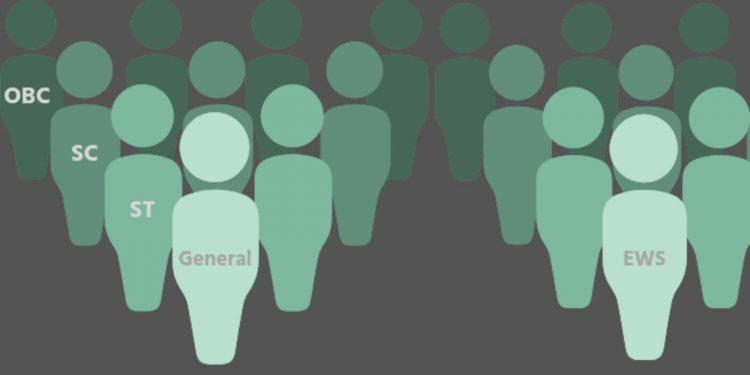Data Suggests That 10% EWS Reservation Scheme is Unsubstantiated and Baseless

In light of the Supreme Court recently inquiring about the union government’s rationale behind the income criteria it has fixed for deciding who can benefit from its recently instituted 10% quota of reserved seats in public employment and higher education institutions for ‘economically weaker sections’, VINEET BHALLA looks into publicly available data for household income and upper caste representation in public employment and higher education to demonstrate that the figures chosen by the government for EWS reservation are prima facie unreasonable and arbitrary.
——-
The Supreme Court, earlier this month, while hearing petitions against the reservation of seats for Other Backward Classes (OBC) and Economically Weaker Section (EWS) in admissions to post-graduate medical courses through the National Eligibility cum Entrance Test (Postgraduate) (NEET PG), sought an explanation from the union government for the rationale behind fixing eight lakh rupees as the upper limit for EWS income criteria.
A three judge bench of the apex court, consisting of Justices D.Y. Chandrachud, Vikram Nath and B.V. Nagarathna, specifically quizzed the Additional Solicitor General what was the exercise undertaken and data used to arrive at the figure, and if this income criterion could be applied uniformly across the country.
The matter will next be heard tomorrow.
The bench’s comments, however, bring fresh attention to the rather specious and unsound income criteria that has been set by the government for the EWS quota.
Also read: Rethinking the Debate on Reservations
Background of EWS reservation
In 2019, the Parliament passed the Constitution (One Hundred and Third) Amendment Act, as per which Articles 15(6) and 16(6) were inserted into the Constitution to allow the State to reserve posts and seats for EWS candidates in public services and educational institutions respectively. A 10% ceiling has been set for such reservations, which are to be independent of all other reservations made for other groups.
According to a memorandum issued by the union government soon after the constitutional amendment, only those “[p]ersons who are not covered under the scheme of reservation for SCs, STs and OBCs and whose family has gross annual income below Rs 8.OO lakh (Rupees eight lakh only) are to be identified as EWSs for benefit of reservation. Income shall also include income from all sources i.e. salary, agriculture, business, profession, etc. for the financial year prior to the year of application.” Persons whose families own landholdings of a certain size (such as at least five acres of agricultural land, or a residential flat of at least 1,000 sq. feet) are excluded from the purview of this reservation.
Soon after the amendment, over 20 petitions were filed before the Supreme Court challenging its constitutional validity. In August 2020, a three-judge bench of the Supreme Court referred the matter to a larger five-judge Constitutional bench.
The latter is yet to conclusively decide on the matter. Meanwhile, the union and state governments have begun extending the 10% EWS reservation in public jobs and educational institutions.
It is not my intention to comment on the constitutionality, or lack thereof, of the EWS reservation (as an aside, journalist and writer Dilip Mandal makes an excellent and comprehensive case for the unconstitutionality of EWS reservation here), but to analyse it from the perspective of the questions posed by the Supreme Court earlier this month: is there any data available to justify the reservation? And what can the available data tell us about the efficacy of such reservation?
What the numbers say
According to the 2011-12 National Sample Survey Organization report on Key Indicators of Household Consumer Expenditure, the per capita income of the richest 5% of Indians was merely Rs 4,481 in rural areas and Rs 10,281 in urban areas. So if a household belonging to the top 5% in urban areas has even as many as five earning members, the family’s monthly income will amount to Rs 51,405 and its annual income, about six lakh rupees; even accounting for inflation since 2012, this is still a whopping 25% lower than the limit set under the new reservation norm.
Moreover, as per the Socio-Economic Caste Census 2011, only 8.25% rural households have a monthly income of more than Rs 10,000 (which amounts to an annual income of over 1.2 lakh rupees). Similarly, according to the Agriculture Census 2015-16, about 86% of land holdings in India are smaller than the prescribed limit of 5 acres.
As per data from the BCG (Center for Customer Insight) for 2016, about 76% Indian households had an annual income of below USD 7,700, which, going by the exchange rate prevailing at that time, would equate to 5.15 lakh rupees.
It must be noted, however, that all this data is for all Indian households, and doesn’t account for differentiation on the basis of caste.
Analysing publicly available data, Business Today concluded that “[i]ronically, nearly 100% of Indian households will be eligible beneficiaries under the above-mentioned income criterion as per government data.”
It is mind-boggling that a reservation scheme of 10% that has been enacted to benefit “economically weaker sections” of the society covers a large majority of the population. One wonders, then, as did the Supreme Court, what exercise the government undertook to arrive at the annual household income ceiling of eight lakh rupees and the reservation quota of 10%. In light of the household income data, both numbers seem extremely arbitrary.
Also read: Unfolding the Enigma of Reservation
Where is the data to support the rationale for EWS reservation?
The Statement of Objects and Reasons for the 103rd Constitutional Amendment Bill stated: “At present, the economically weaker sections of citizens have largely remained excluded from attending the higher educational institutions and public employment on account of their financial incapacity to compete with the persons who are economically more privileged. … to ensure that economically weaker sections of citizens … get a fair chance of receiving higher education and participation in employment in the services of the State, it has been decided to amend the Constitution of India.”
This implies that upper-caste groups (that is, those that do not belong to SC, ST or OBC groups and therefore cannot avail of reservations meant for them) which fall in the EWS category are underrepresented in public employment and institutions of higher education.
As per data from 78 union government ministries and departments, the representation of SCs, STs and OBCs in the posts and services under the Central Government, as on 01.01.2016, was 17.49%, 8.47% and 21.57% respectively. This means that 52.47% of central government employees at these ministries and departments are from upper castes.
According to the All India Survey on Higher Education, across the total estimated student enrolment of 3,85,36,359 in higher educational institutions, SC, ST and OBC students account for 14.7%, 5.6% and 37% enrolment respectively. This means that 42.7% of the enrolment belongs to upper caste students.
Now, are an overwhelming majority of these upper caste public employees and upper caste students at higher education institutions from families with annual household incomes of over eight lakh rupees per annum? The fact that most Indian households come within that bracket suggests that that is not the case, but even if it were so, the fact of the matter is that there is no publicly available data to suggest that that is the case.
In the absence of data to underscore this ostensible representation of ‘EWS’ upper castes, and in light of the fact that most Indian households, including upper caste ones, come within the government’s EWS criteria, the rationale for EWS representation has no legs to stand on.
The union government’s response to the Supreme Court’s queries, then, are eagerly awaited to shed light on this conundrum.
(Vineet Bhalla is a Delhi-based lawyer, and Assistant Editor at The Leaflet. The views expressed are personal.)
Get the latest reports & analysis with people's perspective on Protests, movements & deep analytical videos, discussions of the current affairs in your Telegram app. Subscribe to NewsClick's Telegram channel & get Real-Time updates on stories, as they get published on our website.
























